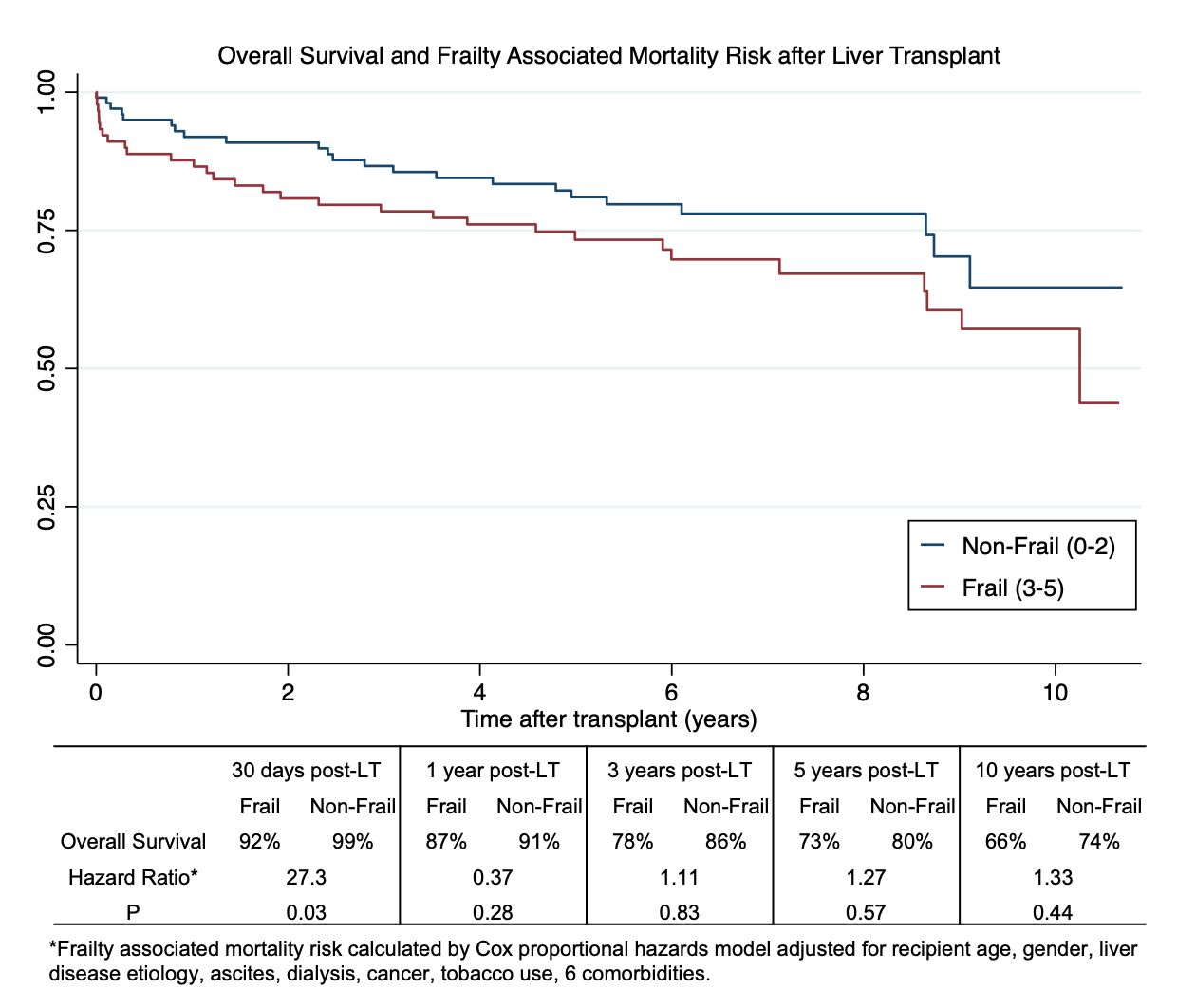Pre-Transplant Frailty is Associated with 30-Day Mortality but Not Long-Term Survival After Liver Transplantation
Department of Surgery, University of Michigan Health System, Ann Arbor, MI
Meeting: 2021 American Transplant Congress
Abstract number: 241
Keywords: Liver transplantation, Mortality, Outcome, Survival
Topic: Clinical Science » Liver » Liver: Recipient Selection
Session Information
Session Name: Liver Recipient Selection
Session Type: Rapid Fire Oral Abstract
Date: Monday, June 7, 2021
Session Time: 4:30pm-5:30pm
 Presentation Time: 4:30pm-4:35pm
Presentation Time: 4:30pm-4:35pm
Location: Virtual
*Purpose: Frailty predicts waitlist death in liver transplant (LT) candidates, but the impact of frailty on mortality after LT is unknown. We investigated the association between pre-transplant frailty and survival after LT.
*Methods: We analyzed post-transplant outcomes in 224 LT recipients enrolled in a prospective study of frailty in LT candidates at our institution from 07/2009-01/2016. Patients with a frailty assessment in the year prior to LT were included. Patients with assessments more than one year from LT (n=47) or incomplete data (n=1) were excluded. Frailty was assessed by the 5-item Fried frailty instrument measuring gait speed, grip strength, unintentional weight loss, self-reported exhaustion, and physical activity. Demographic and clinical data at the time of frailty assessment and post-LT outcomes were collected. Frailty was defined as a Fried frailty score ≥ 3. The primary outcome was post-transplant survival, analyzed by Kaplan-Meier and Cox proportional hazards models. Inspection of Kaplan-Meier curves showed significantly higher mortality in the first 30 days. To account for non-proportional hazards, survival was examined in two time intervals: ≤30 days and >30 days after LT.
*Results: 176 patients met inclusion criteria, of which 49% (n=86) were frail. Frail patients had higher baseline MELD, greater frequency of ascites, and lower frequency of cancer. There was no difference in demographics or other comorbidities by frailty (Table 1). Overall post-transplant survival was 69.9% with median follow up time of 5.8 years. Frailty was associated with a significantly higher risk of death in the first 30 days after LT (HR=27.3, p=0.03). There was no significant difference in 1-year, 3-year, 5-year, or 10-year adjusted post-transplant survival between frail and non-frail patients. Unadjusted Kaplan-Meier curves stratified by frailty and adjusted Cox proportional hazard ratios are shown in Figure 1.
*Conclusions: Frailty was associated with early mortality, but not associated with decreased long term survival after LT. Given the well-established association between frailty and waitlist mortality, frail patients may benefit from expedited allocation and prehabilitation.
| Non-Frail (n=90) | Frail (n=86) | P | |
| Age (median(IQR)) | 54.9(45.9-61.4) | 57.7(50.7-61.1) | 0.090 |
| Female %(n) | 24.4(22) | 27.9(24) | 0.549 |
| BMI (mean(SD)) | 29.7(6.0) | 29.3(6.3) | 0.646 |
| Diabetes %(n) | 25.6(23) | 33.7(29) | 0.251 |
| Any cancer %(n) | 53.3(48) | 23.3(20) | <0.001 |
| Ascites %(n) | 31.1(28) | 59.3(51) | <0.001 |
| Lab MELD (mean(SD)) | 16(6.4) | 19(6.9) | <0.001 |
To cite this abstract in AMA style:
Anderson M, Valbuena V, Englesbe M, Sonnenday C. Pre-Transplant Frailty is Associated with 30-Day Mortality but Not Long-Term Survival After Liver Transplantation [abstract]. Am J Transplant. 2021; 21 (suppl 3). https://atcmeetingabstracts.com/abstract/pre-transplant-frailty-is-associated-with-30-day-mortality-but-not-long-term-survival-after-liver-transplantation/. Accessed December 20, 2025.« Back to 2021 American Transplant Congress

